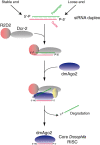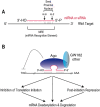MicroRNAs: biogenesis and molecular functions
- PMID: 18226106
- PMCID: PMC8095604
- DOI: 10.1111/j.1750-3639.2007.00121.x
MicroRNAs: biogenesis and molecular functions
Abstract
Small regulatory RNAs are essential and ubiquitous riboregulators that are the key mediators of RNA interference (RNAi). They include microRNAs (miRNAs) and short-interfering RNAs (siRNAs), classes of approximately 22 nucleotide RNAs. miRNAs and siRNAs bind to Argonaute proteins and form effector complexes that regulate gene expression; in animals, this regulation occurs primarily at the post-transcriptional level. In this review, we will discuss our current understanding of how miRNA and siRNAs are generated and how they function to silence gene expression, focusing on animal and, in particular, mammalian miRNAs.
Figures







References
-
- Ambros V (2004) The functions of animal microRNAs. Nature 431:350–355. - PubMed
-
- Ameres SL, Martinez J, Schroeder R (2007) Molecular basis for target RNA recognition and cleavage by human RISC. Cell 130:101–112. - PubMed
-
- Aravin AA, Hannon GJ, Brennecke J (2007) The Piwi‐piRNA pathway provides an adaptive defense in the transposon arms race. Science 318:761–764. - PubMed
-
- Bagga S, Bracht J, Hunter S, Massirer K, Holtz J, Eachus R et al (2005) Regulation by let‐7 and lin‐4 miRNAs results in target mRNA degradation. Cell 122:553–563. - PubMed
-
- Bartel DP, Chen CZ (2004) Micromanagers of gene expression: the potentially widespread influence of metazoan microRNAs. Nat Rev Genet 5:396–400. - PubMed
Publication types
MeSH terms
Substances
Grants and funding
LinkOut - more resources
Full Text Sources
Other Literature Sources
Molecular Biology Databases

